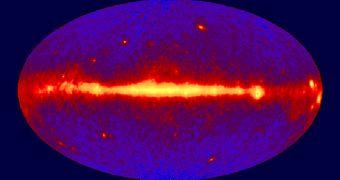Despite studying the Universe for the better part of three years, the NASA Fermi Space Telescope has yet to discover tell-tale signs confirming the existence of dark matter. These signs should theoretically exist at certain gamma-ray wavelengths, but the observatory found no evidence of their existence.
The reason why this is important is because Fermi is the most advanced gamma-ray telescope ever built. This means that it should theoretically be able to see radiations that similar instruments cannot.
Dark matter is believed to be composed of weakly-interacting massive particles (WIMP), which are their own antimatter particles. As such, when two of them collide they annihilate each other.
These collisions should – at least in theory – produce gamma-rays at specific wavelengths, which would look like spikes in Fermi's diagrams. However, the telescope has thus far found no evidence of such spikes in its readings.
Astrophysicists are currently pondering this dilemma, trying to figure out whether the theoretical models are wrong, or if something affects the telescope, or if dark matter is real at all. Scientists cannot really tell at this point why Fermi is not seeing signs of dark matter.
To the telescope's defense, no other detectors in the world were able to identify or study WIMP either. Dark matter is currently being analyzed only through the effects it's having on normal, baryonic matter, of which the visible Universe is composed.
Dark matter is now believed to make up nearly 23 percent of the mass of the Universe, while another 73 percent is accounted for by dark energy. Baryonic matter, of the type that makes up galaxies, stars, black holes and everything else that is visible, accounts for only 4 percent of the universal mass.
Discovering this stuff would finally confirm the current cosmological model, and allow astronomers to come to an agreement on the nature of the Big Bang. Without discovering dark matter and dark energy, the fact that the Universe expands at its current rate makes no sense.
Theoretically, it shouldn't do so. The thinking is that an outside force – dark energy – is pulling galaxies closer together into clusters, while at the same time increasing the distance between these clusters.
Dark matter's role is to explain why galaxies have such a huge gravitational pull when they have insufficient mass to account for such a large one. Under Albert Einstein's theory of general relativity, the force of gravity is directly related to the mass of the object producing it, Daily Galaxy reports.

 14 DAY TRIAL //
14 DAY TRIAL //